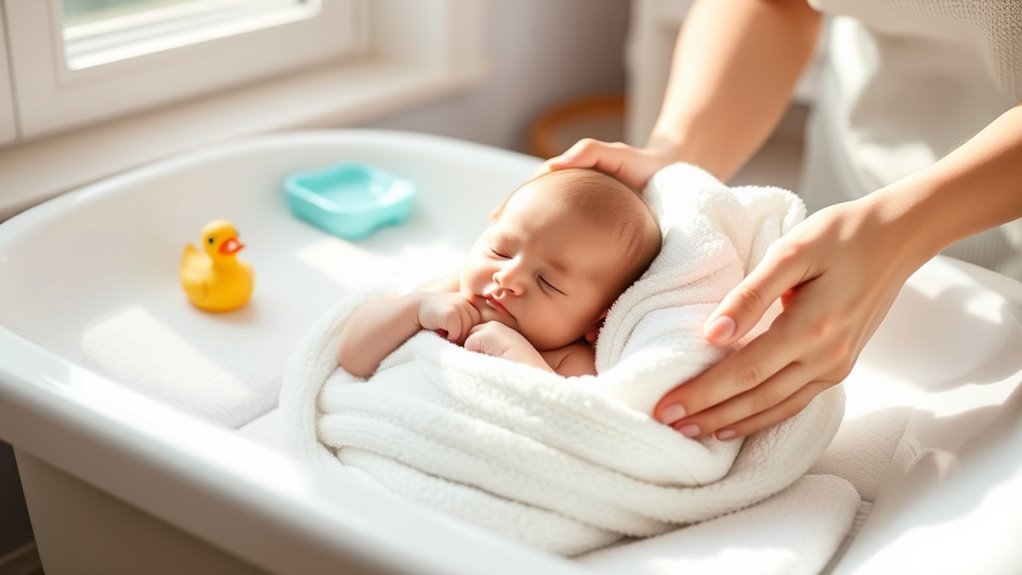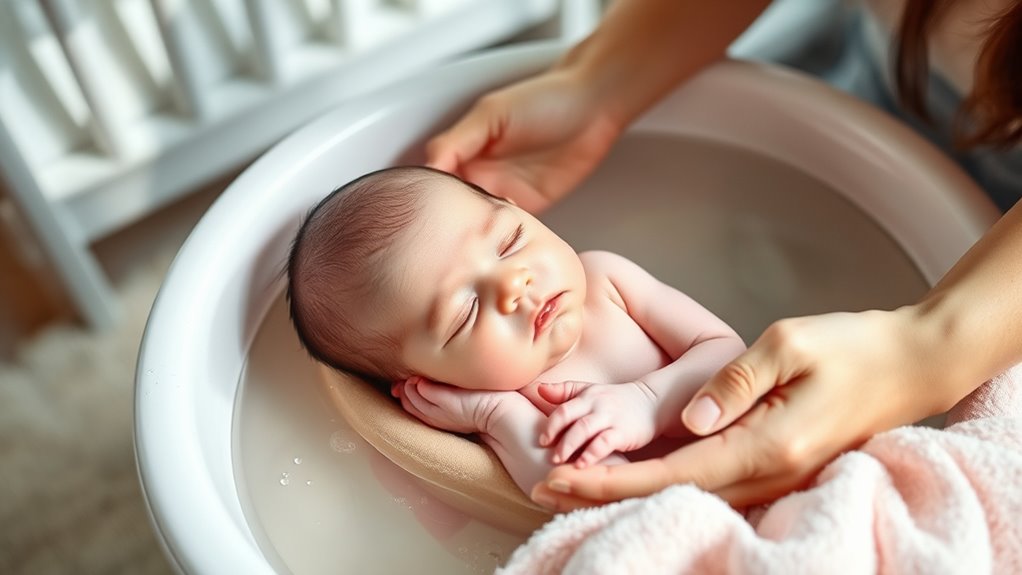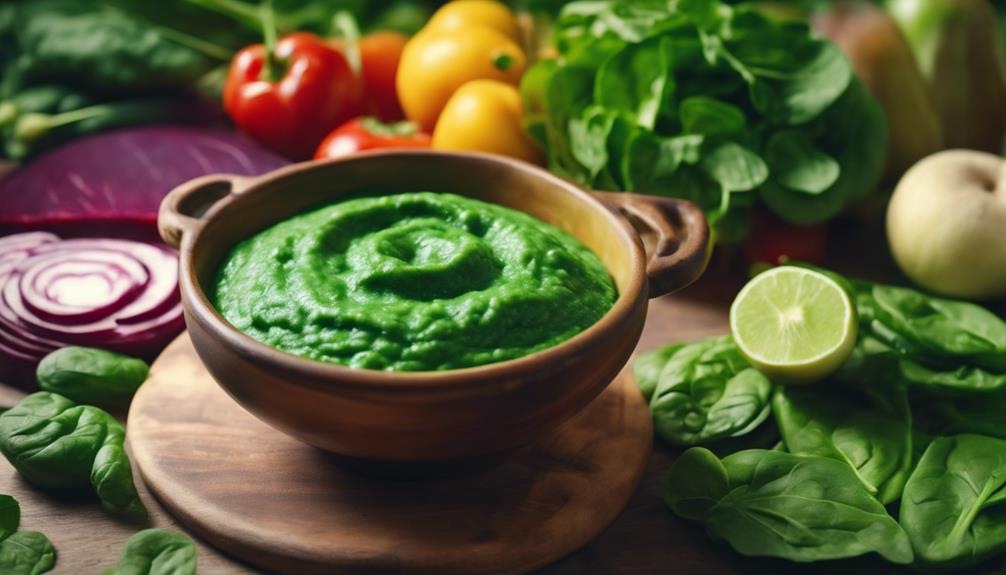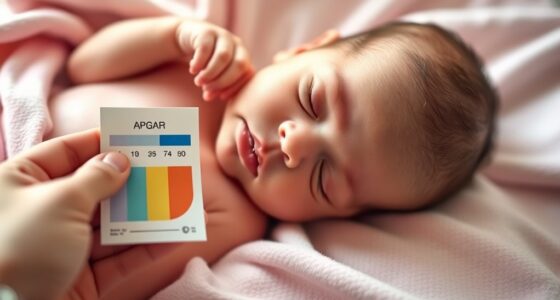In the first weeks, bathe your baby 2-3 times a week using warm water around 98-100°F, checked with your wrist or elbow. Keep all supplies within reach and never leave your baby unattended. Gently wash with a soft cloth, paying attention to creases, and rinse thoroughly. Pat dry, then apply a gentle moisturizer. Maintaining a warm, safe environment helps shield your baby’s delicate skin and guarantees comfort. Continue to explore best practices for safe, gentle bathing routines.
Key Takeaways
- Bathe your newborn 2-3 times weekly with water around 98-100°F, testing with your wrist or elbow for safety.
- Gather all supplies beforehand and never leave the baby unattended during bathing.
- Support the baby securely with both hands, using gentle strokes and a soft washcloth.
- Focus on cleaning creases, behind ears, and diaper area, rinsing thoroughly to prevent irritation.
- Pat dry gently, apply fragrance-free moisturizer, and keep the environment warm to ensure comfort and safety.

In the first weeks after your baby’s arrival, safe bathing is essential to protect their delicate skin and maintain good hygiene. During this time, it’s important to use gentle water when bathing your newborn. The water should be warm but not hot—around 98 to 100 degrees Fahrenheit—to prevent burns and discomfort. Always test the temperature with your wrist or elbow before gently pouring it over your baby’s skin. This helps ensure their skin isn’t exposed to water that’s too hot or cold, which can cause irritation or chills.
Establishing a consistent bathing schedule helps keep your baby clean without overdoing it. In the beginning, bathing two to three times a week is sufficient, as newborns don’t get very dirty and their skin can dry out easily. On non-bathing days, you can simply use a damp cloth to gently wipe your baby’s face, neck, hands, and diaper area. When you do bathe your baby, make sure to gather all necessary supplies beforehand—like a soft washcloth, mild baby soap, a clean towel, and fresh clothes—so you don’t have to leave your little one unattended. Keeping everything within arm’s reach ensures safety and makes the process smoother.
During bath time, support your baby securely with your hands, especially when they’re in the water. Never leave your baby unattended, even for a second. Use gentle strokes and avoid scrubbing; a soft washcloth works well for cleaning their sensitive skin. Pay special attention to the creases behind the ears, neck, and around the diaper area—these spots can trap moisture and dirt. As you bathe your baby, remember that gentle water and mild, fragrance-free baby soap are best to protect their fragile skin. Rinse thoroughly to remove any soap residue, which can cause irritation. Incorporating proper water temperature is crucial for your baby’s safety and comfort, aligning with the importance of high-quality projector images in creating an immersive viewing experience.
After bathing, gently pat your baby dry with a soft towel, making sure to dry all the creases and folds. Applying a gentle, fragrance-free moisturizer can help keep their skin soft and prevent dryness. During the first weeks, keep the bathing environment warm and cozy to prevent your baby from getting cold. Always check the room temperature and keep the water warm but not hot, adjusting as needed. Over time, as your baby grows, you’ll find a bathing routine that works best for your family. But initially, focusing on a gentle water temperature and a consistent bathing schedule will help keep your newborn safe, comfortable, and clean.
Frequently Asked Questions
When Can I Start Using Soap During My Baby’s Bath?
You can start using a gentle, fragrance-free soap during your baby’s bath once the umbilical cord falls off and the area heals, usually after about a week. Choose a soap formulated for sensitive skin to avoid irritation. During the first baths, focus on gentle cleansing of the face and body without scrubbing. Always monitor your baby’s skin for any signs of sensitivity or rash, and consult your pediatrician if needed.
How Do I Handle a Baby With Umbilical Cord Stump?
Think of it as walking on thin ice—you need to be gentle. To handle your baby’s umbilical cord stump, keep it clean and dry with proper umbilical cord care. Use a soft cloth for bathing and avoid submerging the stump until it falls off. Stick to sponge baths, gently pat dry, and make certain no soap or water irritates the area. This careful approach keeps your baby safe and comfortable.
Is It Safe to Bathe My Newborn Daily?
You can bathe your newborn daily if they enjoy it, but it’s often best to limit baths to a few times a week to avoid dryness. Use gentle, soothing techniques to make bath time a bonding experience, like talking softly or singing. Prioritizing parental bonding during baths helps your baby feel secure, while careful handling keeps them safe, especially with their delicate skin and healing umbilical area.
What Temperature Is Safest for My Baby’s Bathwater?
A gentle touch sets the tone for your baby’s bath time. The safest bathwater temperature for your little one is around 98.6°F (37°C), similar to body temperature. Use a thermometer to check the water, ensuring it’s not too hot or cold. Maintaining the right bathwater temperature is essential for your baby’s safety, preventing burns and discomfort, and making bath time a soothing, safe experience for your precious bundle.
How Can I Prevent My Baby From Slipping During Bath Time?
To prevent your baby from slipping during bath time, always use slip prevention measures. Place a non-slip bath mat in the tub to provide traction, and hold your baby securely with one hand while supporting their head and neck. Never leave your baby unattended, even for a moment. Keep the bathing area dry and clear of obstacles, ensuring a safe environment that minimizes the risk of slipping and accidents.
Conclusion
Now that you know the essentials, you can confidently keep your little one safe during their first weeks. Remember, gentle baths and warm water are your best allies. Think of it as tending to a fragile rose in your garden—delicate, yet resilient with your loving care. Trust your instincts, stay attentive, and enjoy these precious moments. Soon, your tiny miracle will be splashing happily, and your efforts will feel as timeless as a maiden’s first dance.









